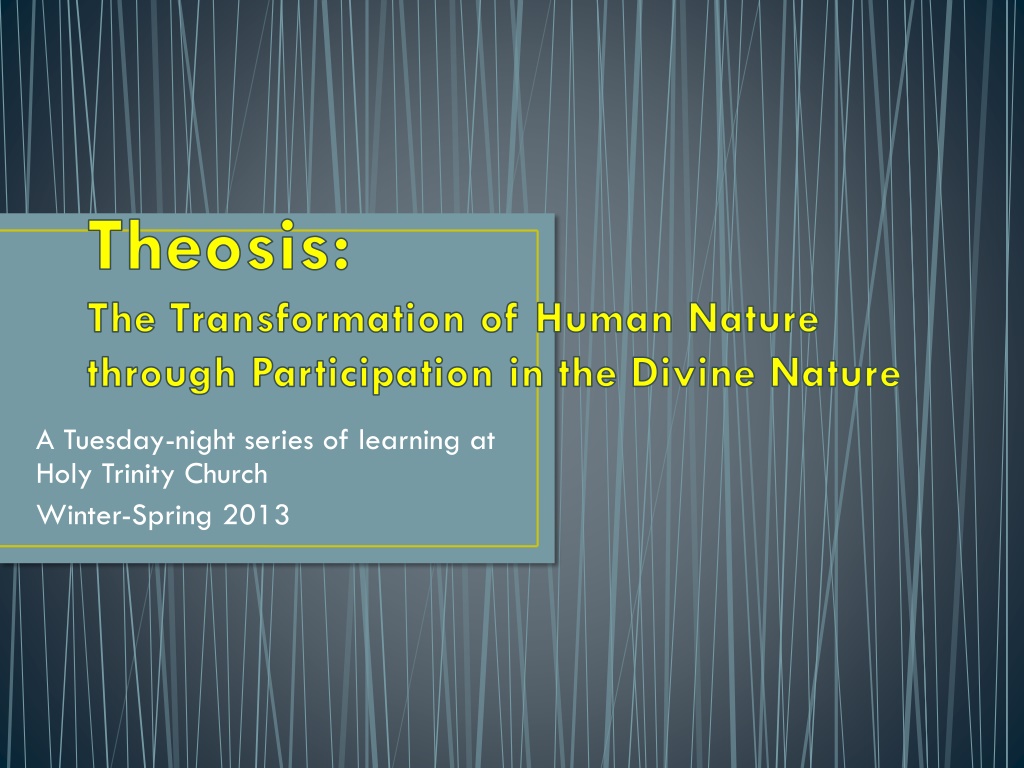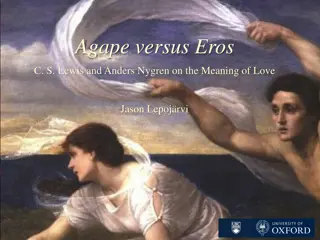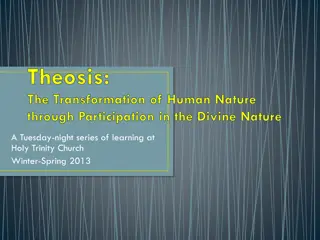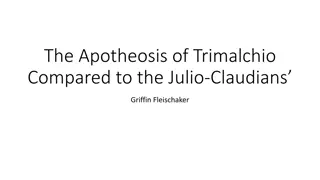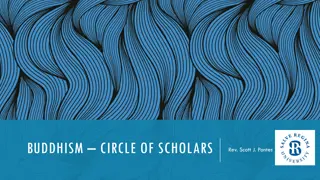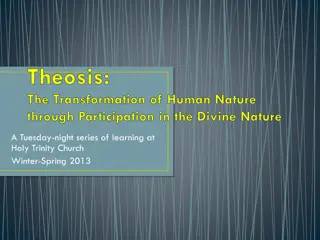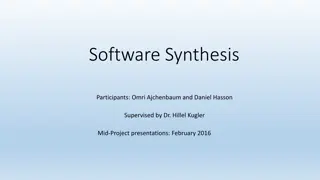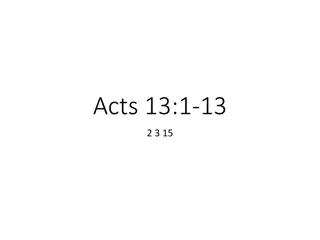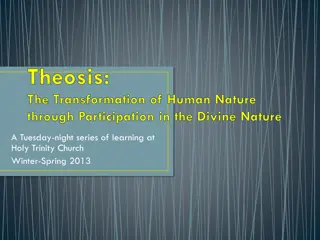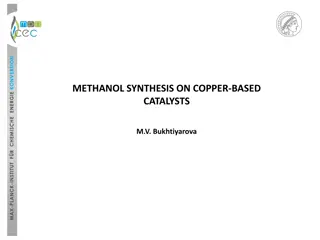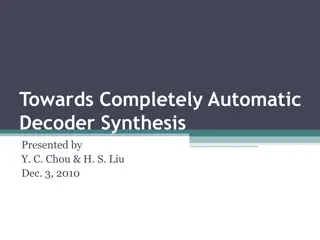Exploring Deification: Theosis and Monastic Synthesis in Early Christian Thought
Explore the concept of theosis, the transformation of human nature through participation in the divine, and its development in early Christian theology. Delve into the Monastic Synthesis, with insights from key figures such as St. Maximus the Confessor, Evagrius Ponticus, and Macarius the Great, as they discuss deification, spiritual struggle, prayer, and the journey towards becoming children of God.
Download Presentation

Please find below an Image/Link to download the presentation.
The content on the website is provided AS IS for your information and personal use only. It may not be sold, licensed, or shared on other websites without obtaining consent from the author. Download presentation by click this link. If you encounter any issues during the download, it is possible that the publisher has removed the file from their server.
E N D
Presentation Transcript
Theosis: The Transformation of Human Nature through Participation in the Divine Nature A Tuesday-night series of learning at Holy Trinity Church Winter-Spring 2013
The Monastic Synthesis So far we have seen deification as a theological doctrine in the hands of the great Fathers: a metaphor for salvation, a theological weapon against Gnosticism, Arianism and Nestorianism, and a tool for dialogue with pagan thought. Starting in the late 4thcentury, with the expansion of monasticism in the Empire, deification received a parallel exposition in the monastic literature, leading to what Russell calls The Monastic Synthesis. The climax of this stage in development of the deification concept came with the writings of St. Maximus the Confessor, perhaps the most profound of all the Fathers and a deeply mystical/theological writer.
The Monastic Synthesis - Evagrius Evagrius Ponticus (346-99) wrote extensively on the spiritual struggle. True prayer elevates the monk to the angelic life ( ). But the knowledge beyond which no other knowledge exists is only attained on the last day when the mind arises to contemplate the Oneness and the Aloneness of the Word ( ). Evagrius was heavily influenced by Origen, and so was included in the anathemas of 553 against Origenism. Gnosticizing approach to deification sees goal of spiritual life as total assimilation to Christ through shedding of the material element that accounts for individuality.
The Monastic Synthesis - Evagrius According to the 15 Anathemas of 553, the Origenists held that all intelligent beings Christ, the angels, human beings and demons formed a spiritual continuum which pre-existed the Fall. These created intelligences (noes) lost their original unity when divine love grew cold in them. Angels grew cold the least and thus have the most subtle bodies. Human beings grew cooler and became souls enclosed in material bodies. Demons grew coldest of all. Only a single nous remained steadfast in contemplation of God. This unfallen nous united himself to the Word and became Christ. At end of time matter will cease; only noes will be left and return to their original undifferentiated unity.
The Monastic Synthesis - Macarius Macarius the Great (4thc), Syrian monastic (pseudonym?): [The spiritually regenerated] person is counted worthy to arrive at the good measure of the Spirit and receives through the divine power a pure humanity ( ) and becomes greater than himself. For such a person is deified ( ) and becomes a son of God, receiving the heavenly imprint in his soul. For God s elect are anointed with sanctifying oil and become officeholders and kings (Hom 15). This anointing by the Spirit creates a new humanity, transformed into a divine nature, having become christs and gods and children of God (Hom 34).
The Monastic Synthesis - Macarius Monastic celibacy and detachment are only external. Evil remains in the heart. A saint is a person who has been sanctified in his or her inner self ( ) as a result of unceasing dedication to the cross of Christ. Epektasis, the never-ending progress in spiritual life: In Gregory of Nyssa it is progress from light through cloud into darkness. In Macarius it is always toward light: the soul is illuminated by the beauty of Christ and becomes a throne and dwelling of God (Hom 1). At the end of time, the resurrected body will share in the glory of the soul and will put on the heavenly dwelling not made by human hands, the glory of divine light.
The Monastic Synthesis - Diadochus Diadochus of Photice (c. 400-87) explained the stages of the spiritual life leading to deification. Growth in spiritual life = ascent from image to likeness. Baptism conceals grace in the soul of the baptized. First stage: whole person turns to the Lord grace first makes itself felt as sensible warmth in the heart. Second stage: person advances in observance of commandments grace felt as fire burning impurities. Third stage: person clothed in all the virtues grace illuminates person s entire nature, experienced as profound feeling of intense love for God. Ultimately, the intellect becomes entirely transparent and sees its own light!
The Monastic Synthesis - Dionysius Pseudo-Dionysius the Areopagite, unknown Syrian who lived around year 500, was the first to offer a definition of deification: Now this blessed Deity which transcends everything and which is one and also triune has resolved, for reasons unclear to us but obvious to itself, to ensure the salvation of rational beings, both ourselves and those beings who are our superiors. This can only happen with the divinization of the saved. And divinization (theosis) is to attain likeness to God and union with God so far as possible ( ). (Ecclesiastical Hierarchy 1.3) Deification is merely our participation in one of the divine attributes, that of deity.
The Monastic Synthesis - Dionysius In our earthly existence, God brings us together in the eucharistic assembly. Our earthly hierarchies imitate the celestial hierarchies. Lights are images of the immaterial gift of light. The beautiful odors of incense represent the diffusion of concepts. Reception of the eucharist symbolizes our participation in Jesus. And so it goes (CH 1.3) In discussing the Liturgy, he emphasizes the understanding of the symbols rather than participation in the body and blood of Christ. The symbols raise the mind to unity and simplicity, enabling it to participate in the divine attributes of goodness, wisdom, oneness and deity. Return to God is a direct reaching out to personal, triadic God, who responds with gift of himself in deification.
The Monastic Synthesis - Maximus Maximus the Confessor (580-662) was one of the most complex of Christian thinkers and one of the most intensely studied in the last 70 years, since the publication in 1941 of Hans Urs von Balthasar s epic Kosmische Liturgie, translated into English, Cosmic Liturgy: The Universe According to Maximus the Confessor. Other important studies: Lars Thunberg, Microcosm and Mediator: The Theological Anthropology of Maximus the Confessor. A simplified, shortened version was published as Man and the Cosmos: The Theological Vision of St. Maximus the Confessor, SVS Press. Torstein Theodor Tollefsen, The Christocentric Cosmology of St. Maximus the Confessor, Oxford, 2008. Melchisedec T r nen, Union and Distinction in the Thought of St. Maximus the Confessor, Oxford, 2008.
The Monastic Synthesis - Maximus Known for extensive writings on love. (see 400 Chapters) For nothing is more truly godlike than divine love, nothing more mysterious, nothing more apt to raise up human beings to deification ( ) (Ep. 2). The law and the prophets were succeeded by the mystery of love, which out of human beings makes us gods, and reduces the individual commandments to a universal meaning ( ) (Ep. 2). This is not the natural yearning of the soul for union with God but a divine gift which incorporates every virtue and elevates humanity to the likeness of God.
The Monastic Synthesis - Maximus God gave humans four divine attributes: being and ever- being, goodness and wisdom. The first two belong to our essence, the other two are for us to choose, in order that the creature may become by sharing (participation), what God is in essence (Cap. Car. 3.25). Thus, by participating in the divine attributes through the exercise of our will, we become what God is while still remaining creatures. When we pray, let our aim be this mystery of deification, which shows us what we were once like and what the self- emptying (kenosis) of the only-begotten Son through the flesh has now made us . . . . (Or. Dom. 5)
The Monastic Synthesis - Maximus The Mystagogia (a commentary on the Liturgy) is one of his most read works. In it he sees the church building as an image of God, then of the world, and finally of a human being. This use of symbolism connects to his idea of the human being as a microcosm, who needs to act in accordance with his/her logos in such a way that the whole cosmic building would end up in a communion of peace and love across the whole spectrum of created essential differences, to culminate in God s self-communication which effects the glorification of created otherness. (T. T. Tollefsen, Activity and Participation in Late Antique and Early Christian Thought, Oxford, 2012, page 148)
The Monastic Synthesis - Maximus He sees the Liturgy as a series of ascending levels of unity: Kiss of peace (reconciliation with each other and with God); The Creed (thanksgiving for salvation); The Holy, Holy, Holy (union with the angels); The Lord s Prayer (adoption in the Spirit); One is holy just before communion symbolizes the ascent of the faithful in a manner beyond knowledge to the unknowable monad, deified by grace, and made like the monad by participation in an indivisible identity so far as this is possible ( , Myst. 13).
The Monastic Synthesis - Maximus But deification is not a private mystical experience, or a self-centered cultivation of the soul in isolation from other people. Deification is the fruit of love, and that is something that precludes the neglect of one s neighbor. A good disposition must manifest itself in an altruistic love that imitates and reciprocates the divine philanthropy: For a work is proof of a disposition. Nothing brings us more easily either to justification or to deification (if I may speak thus), nothing is more apt to bring about closeness to God, than mercy towards the needy offered from the soul with pleasure and joy (Myst. 24).
Maximus presents a portrait of the deified man: He comes to be in God through attentiveness, since he has not corrupted the logos of being that pre-exists in God, and he moves in God in accordance with the logos of well-being that pre-exists in God, since he is activated by the virtues, and he lives in God in accordance with the logos of ever-being that pre-exists in God. In this life, because he has made a highly impassible habit of mind his own, he is already immovable, and in the life to come, because of the deification which will be given to him, he will lovingly accept and embrace the logoi mentioned above that pre-exist in God, or rather, he will accept and embrace God himself in whom the logoi of the good are established.
And he is a part of God, as one who exists, on account of the logos of his being which is in God, as one who is good, on account of the logos of well-being which is in God, and as a god, on account of the logos of his ever-being which is in God. He has respected these and operated in accordance with them. By these he has inserted himself totally into God alone, and has imprinted the stamp and form of God alone totally upon himself so that he himself may be a god by grace and be called such, just as God is a man by condescension and is called such on his account, and also so that the power of this reciprocal arrangement may be revealed that deifies man for God through his love for man, and by this beautiful correspondence makes God man, for the sake of man s divinization, and man God for the sake of God s humanization. (Amb. 7)
Deification does not belong to what lies within our potentiality to bring about naturally, since it is not within our power. For no logos of that which transcends nature lies within nature. Therefore deification is not an accomplishment that belongs to our potentiality: we do not possess the potentiality for it by nature, but only through the divine power, since it is not a reward given to the saints in return for righteous works, but is proof of the liberality of the Creator, making the lovers of the beautiful by adoption that which he has been shown to be by nature, according to the logoi which he himself knows, so that he may both be perfectly known and also remain completely beyond comprehension... (Opusc. 1) The ascetic struggle does not create virtue; it only manifests it.
God and man are paradigms of one another, that as much as God is humanized to man through love for mankind, so much has man been able to deify himself to God through love (Amb. 10). Human beings restore the image of God in themselves through responding in love to the divine philanthropia manifested in the Incarnation. The human person unites the created nature with the uncreated through love the whole [creation] wholly interpenetrated ( ) by God, and become completely whatever God is, save at the level of being, and receiving to itself the whole of God himself, and acquiring as a kind of prize for its ascent to God the most unique God himself (Amb. 41).
God forbade the tree of knowledge of good and evil so as to postpone its consumption until after the human came to know his own cause through participation in it by grace, together with the immortality given to him in accordance with grace. And attaining dispassion and immutability, as if he had already become a god by deification, he might safely examine God s creatures with God s permission and receive the knowledge of them as a god, not as a man, possessing by grace and with wisdom the same knowledge of beings as God, through the re-forming of the mind and the senses for deification But instead of fulfilling his vocation and being deified as God intended, the first man himself deified creation ( ). (Thal. Intro.) This misuse of knowledge was the essence of the Fall.
Deification was the goal for which humanity was created. This is spelled out by Maximus in his interpretation of the Wedding Feast at Cana (John 2:1-11). Our first ancestors lacked nothing to prevent them from fulfilling the will of God. The commandment prohibiting them from tasting of the tree of the knowledge of good and evil was not arbitrary. It was for their own good: the knowledge of evil exposes us to the passions, and the passions deify creation. The six jars of the Wedding Feast were empty as a result of the Fall, their contents squandered. The Savior refilled them with the teaching of the law and the prophets. When he changed the water into wine, a new era was introduced that transcended nature. The law and the prophets were now superseded by the mystery of love in the person of Christ.
The divine Word descended in order that we might ascend. He emptied himself in order that we might be filled with divine glory. Katabasis is followed by anabasis, kenosis by theosis. Christ brought about a situation which surpassed the original creation. He gave humanity a new beginning: through the hypostatic union of the Word with ensouled flesh, which deified us in principle: through the mystery of the passion, which effected our return to obedience: and through the resurrection, which has inaugurated the age of the Spirit. In his own person Christ united heaven and earth, created and uncreated. The logoi are the forms by which the Logos makes himself present in the world. The creation and salvation of the world are knit together in one single divine purpose.
Maximus does not write about himself. Deification for him is not a private mystical experience. Where he does seem to write with personal intensity is in his exposition of the Liturgy. The divine chant kindles an intense desire for God. The hearing of the Gospel brings the mind to union with itself. The singing of the Holy, Holy raises the worshippers to union with the angels. And the reception of the spotless and life-giving mysteries fills them with God and leaves no part of them empty of his presence . It is here in the eucharistic celebration that we can best sense Maximus himself as a contemplative filled with the grace of theosis. (Russell, p. 295 & preceding) With Maximus, deification entered the Byzantine monastic tradition as the goal of the spiritual life.
The Monastic Synthesis - Symeon Symeon the New Theologian (949-1022) followed the teachings of Maximus, but attained a new level of realism in his writings. Indeed, so bold and personal was his way of expression, that he met with great opposition. When he began to venerate the memory of his spiritual father, Symeon the Studite, his critics reacted with suspicion about anything that hinted at contemporary saints or charismatic figures that might pose a challenge to hierarchical authority. They preferred to push saints back into the church s distant past! The critics were also uncomfortable with deification as participation in divine light, preferring to push it into the eschatological state.
In his notorious 15thHymn, he says that we become Christs members, and Christ becomes each of our members even our private parts will be adorned with the beauty of his divinity and glory. And so both my finger and my penis are Christ. Do you tremble or feel ashamed? So then, there are no shameful members! But still you see your flesh as defiled, And in your mind you go through your disgusting practices, And you say, Are you not ashamed of the shameful members? But again I say to you: look at Christ in the womb And notice the things in the womb and escaping the womb, And from whence my God went out and passed through!
The Monastic Synthesis Achieved Deification had its critics, but its theological foundation did not become a topic of discussion again until the 14th century, when it was challenged seriously for the first time by the opponents of Gregory Palamas. The final victory of Palamism in 1368 gave official approval to the doctrine of theosis as an authentic part of the Orthodox theological tradition. But with the fall of Constantinople in the following century and the subsequent ascendancy of scholasticism and Latin influence, deification went underground, only to re-emerge with the Philokalian renaissance of the eighteenth century. Even then, its importance came to be recognized in academic theological circles only in the latter half of the 20thcentury.
